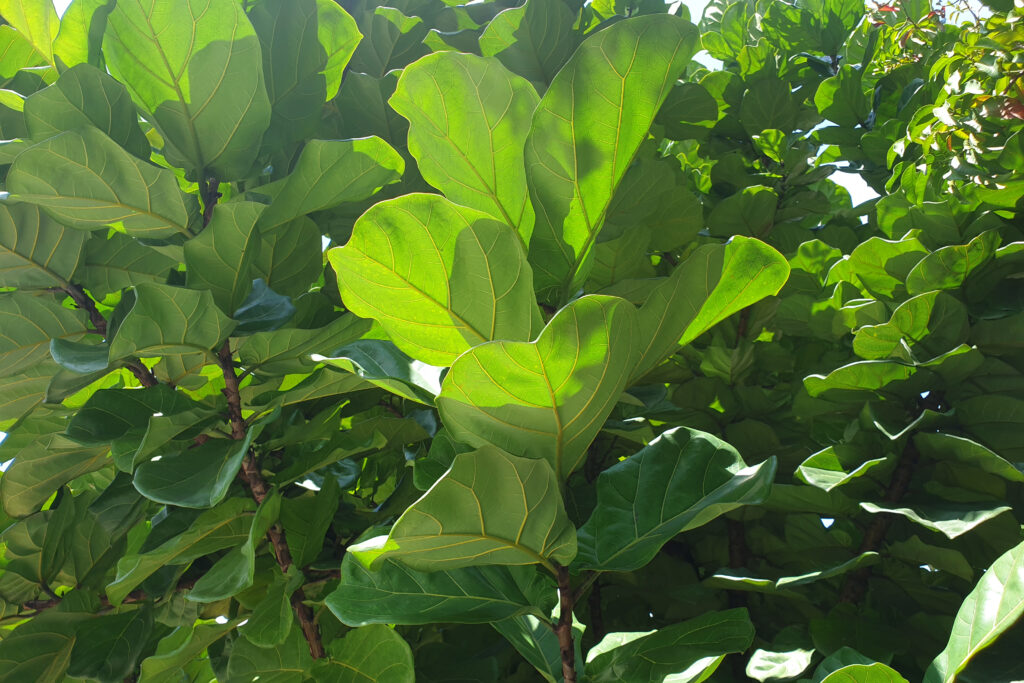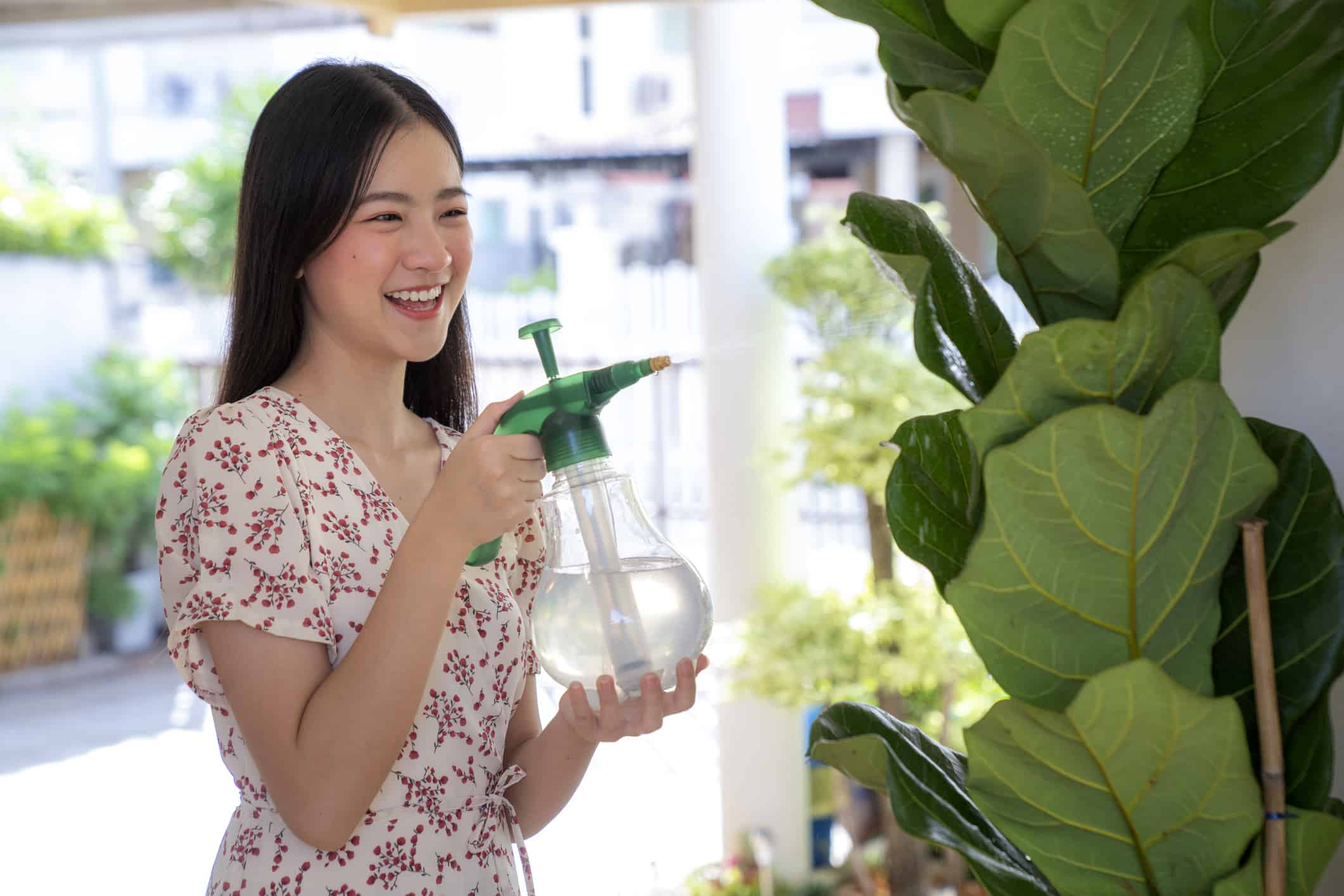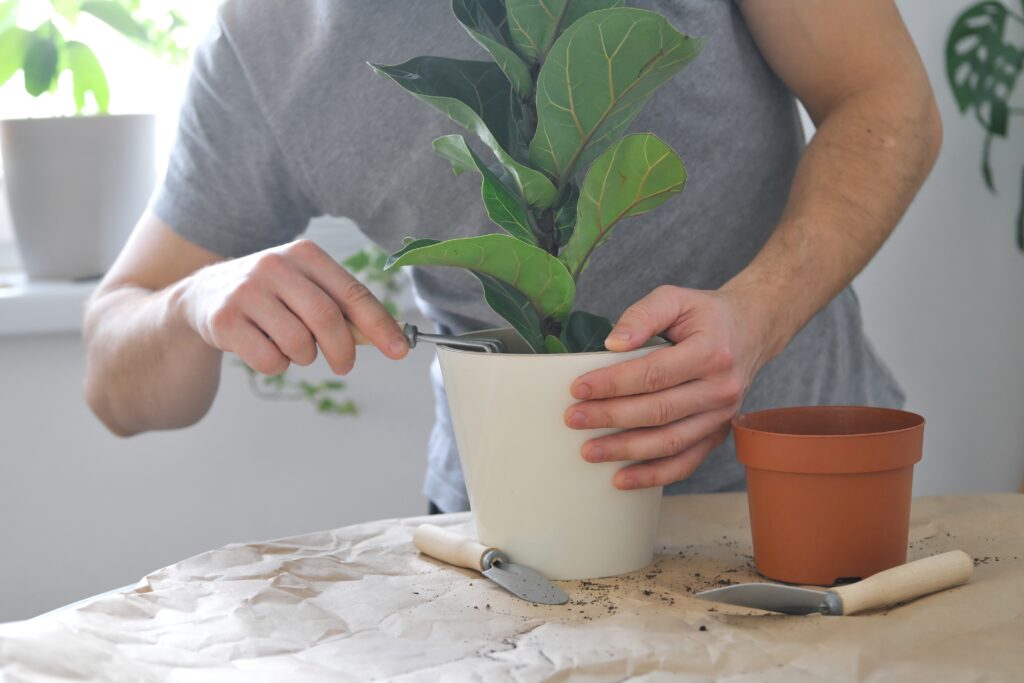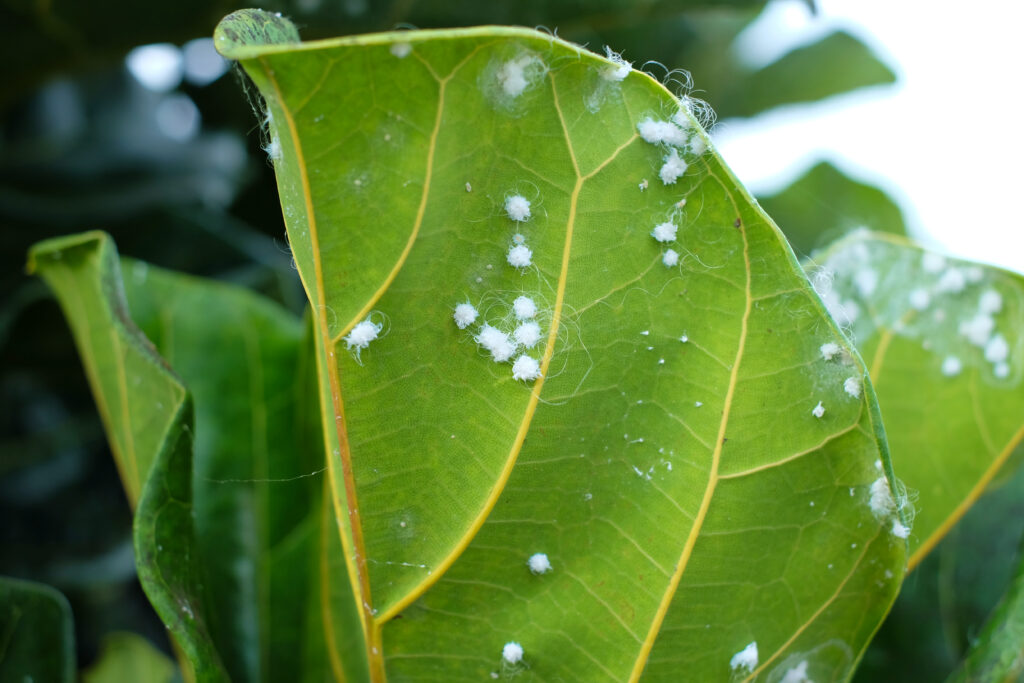Fiddle leaf figs are popular houseplants in temperate areas and favorites in tropical or subtropical gardens. They have large green leaves with prominent veins and get the name fiddle leaf fig from their resemblance to violins. They’ve topped the best houseplant lists in recent years, but some folk have trouble keeping them looking good. Let’s look closely at fiddle leaf fig care: here’s everything you need to know on one page.
Where Do Fiddle Leaf Figs Come From?
Fiddle leaf figs are native to West African lowland rainforests stretching from Cameroon to Sierra Leone. In the wild, they grow up to 50-60 feet tall and produce figs, but away from their native environment, they are very unlikely to fruit because they need lots of sun, humidity, and a specific pollinating wasp.

A sheltered outdoor position is essential for healthy-looking fiddle leaf figs.
©TY Lim/Shutterstock.com
How Much Light Does a Fiddle Leaf Fig Need?
Fiddlers need lots of light to replicate long, sunny African days. This means 6-8 hours of bright sunlight, but the light must be indirect indoors. Magnified sun on fiddler leaves causes leaf scorch, so place your fiddler near a bright window just short of the sun’s reach.
Each season, check if your fiddler is receiving enough or too much sunlight. There’s a lot of difference between mid-summer and mid-winter sun strength.
The same sun is required outdoors, but fiddle leaf figs can cope with direct sunlight outside if they are first acclimatized. Because fiddlers are usually grown under artificial lights, they can get a nasty cold or sunburn shock when they’re first planted out. Minimize the problem by exposing them to an extra hour of sunlight each day before planting up.
If a fiddle leaf fig doesn’t get enough light, it can’t photosynthesize and make its food. Without enough food, it will fade and die. Not enough light is the main reason indoor fiddlers fail to thrive.
If you love them but have a dark home, consider artificial horticultural lights as an alternative to sunlight. This is how they are commercially grown.

Each season, check if your fiddler is receiving enough or too much sunlight.
©Kowit Phatipreechakul/Shutterstock.com
How to Effectively Water and Fertilize a Fiddle Leaf Fig
Overwatering is a houseplant top killer, and it’s a shame because it’s killing with kindness. We all know plants need water, but generally, they don’t need as much as we think.
A fiddle leaf fig needs to dry out a little before it’s watered because consistently wet soil rots its roots, and all plants need air on their roots. The best method is touch and test.
Push a finger into the soil:
- It’s damp = leave it a few days and test it again later.
- It’s dry down to an inch = it’s time for a drink.
Movable fiddle leaf figs should be placed in a bucket or sink of water for a few hours rather than watered from the top. Let them drain clear before replacing them. Give large fiddlers a cup of water until water runs from the base.
Outdoor fiddle leaf figs need water, too, especially if the weather is windy or dry. Container-grown fiddlers are at the most risk of underwatering. Test compost the same way as your houseplants, and if it’s dry down to an inch, soak the pot.
Fiddlers in the ground need extra water during periods of drought. Add a thick layer of organic mulch around the roots to cut down the watering. This not only provides nutrients but also traps moisture.
And speaking of nutrients:
Fertilize a fiddler in the growing season with a weak solution of houseplant food. Follow the instructions carefully to avoid poisoning it. They grow quickly and use up their pot nutrients in double quick time, so don’t skimp on fertilizer.

We all know plants need water, but generally, they don’t need as much as we think.
©iStock.com/NeoPhoto
What About Misting?
Misting is a great way to improve fiddle leaf fig care. All you need to know is rainforests are humid, and misting increases humidity! Spray leaves a few times each week, and you’ll see an improvement.
Misting also helps remove dust build-up, which is best removed with a damp cloth. Clean leaves photosynthesize more effectively. Photosynthesis is the process plants use to make their food, so it’s very important for fiddle leaf fig care.
Keep It Warm
Tropical rainforests are warm! Replicate this warmth in your home, and you’ll have a happy fig. Generally, they need to be above 65 degrees Fahrenheit and should be kept out of drafts, including frequently opened windows and air-conditioned cold spots. Chilly figs throw down their leaves in protest. Conversely, too much radiator heat will cause leaf drop too.
How to Repot a Fiddle Leaf Fig: Everything You Need to Know
Each year, a healthy indoor fiddler puts on around a foot in growth until it reaches 10 feet tall. Its greenery grows taller as its roots grow larger, but roots won’t get any larger than the available pot space. To grow a tall fiddle leaf fig, you’ll ideally repot your fiddler annually.
Choose a new liner pot that’s a few inches bigger than the outgrown one, then gently take your fiddler out and stand it in the new pot’s center. Add extra houseplant compost to fill the gaps. There’s no need to remove any compost clinging to its roots.
Give it a deep watering, and don’t be worried if it sheds a few leaves. Fiddle-leaf fig trees are notorious for dropping leaves, and they will grow back.
Repot outdoor fiddlers the same way, but you might need extra help maneuvering big trees.

To
grow a tall fiddle leaf fig
, you’ll ideally repot your fiddler annually.
©Regina Burganova/Shutterstock.com
Fiddle Leaf Fig Care: All About Pests and Disease
Indoor fiddlers don’t get many pests, but it’s possible that spider mites and aphids could make it indoors. Remove them with soapy water and rub neem oil into leaf crevices to kill eggs. The same applies outdoors, but if the fiddler is large, you could encourage ladybugs and songbirds to your garden because they are natural aphid and spider mite predators.
Mildew is sometimes a problem for fiddle leaf figs, usually due to poor air circulation or underwatering. If underwatering is the reason, see above for a good fiddler watering regime. If your watering set-up is good, then poor circulation might be the problem. Cut back excess leaves so air can reach all its foliage.
Fiddle Leaf Fig Care: Troubleshooting Guide
Does your fiddle leaf fig look less than glorious? Here’s everything you need to know to troubleshoot and get that handsome chap back on track.

If the soil is always soggy around your fiddler, it’s likely what is causing brown leaves.
©Kara Knight/Shutterstock.com
It Is Not Growing
Expect a foot of growth indoors (up to ten feet) each year and more outside. Outdoor fiddlers can top out at 60 feet.
If your fiddler isn’t gaining height and width, give it more light and double down on your touch-and-test watering regime. Consider whether it’s getting enough fertilizer or if its current pot is too small. Is it under aphid or spider mite attack?
It’s Leaning
Plants lean towards the sun, so if yours is leaning, turn the pot. Rotating all your houseplants a quarter turn each week is good practice. This ensures even growth and straight trunks.
Dull Yellow Leaves
Fiddler foliage should be deep to mid-green, so if it’s going yellow, there’s a problem. Again, check out your watering regime because it might be consistently soggy or, at the opposite end of the scale, not be getting enough to drink.
Soggy compost leads to root rot because when roots are rotten, the plant can’t take up water or nutrients and begins to die. Leave soggy soil to dry out, and you may save the plant. If the roots are mushy, that’s game over, I’m afraid.
Yellow leaves can also be caused by too much fertilizer or even a pet urinating in the pot or on its foliage.
No Flowers or Fruit
Fiddle-leaf fig plants produce fruit in their native habitat, but it rarely happens elsewhere. In order to fruit, fiddlers need lots of light, humidity, and a native pollinating fig wasp. They are also dioecious plants, so both a male and a female plant are needed for pollination.
Failure to fruit isn’t much of a loss because fiddle leaf fig fruits are bland and bitter with leathery skin and dry your mouth out. If you want to grow tasty figs, you’ll need to buy a common fig tree.
Rough Brown Foliage Patches
Usually, brown foliage patches are leaf scorch. Check whether direct sunlight is falling on your fiddler or whether it’s near a radiator. If so, move it, but be ready for a tantrum leaf drop. It will recover if it likes the new position.
Brown leaf tips usually indicate too much or too little water.
What’s This White Fluff?
White fluff in between the trunk and leaf junctions are spider mite webs! Look closely, and you’ll spot tiny moving brown dots. They are spider mites, and you can get rid of them with rubbing alcohol or neem oil.

Infestation on leaves of a fiddle leaf fig.
©daguimagery/Shutterstock.com
The photo featured at the top of this post is © Rawpixel.com/Shutterstock.com
Thank you for reading! Have some feedback for us? Contact the AZ Animals editorial team.






